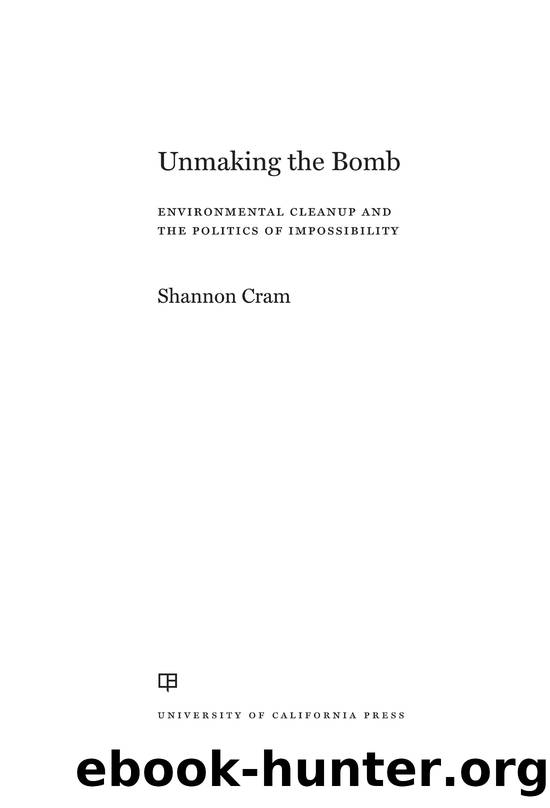Unmaking the Bomb by Shannon Cram;

Author:Shannon Cram;
Language: eng
Format: epub
ISBN: 9780520395138
Publisher: University of California Press
A tumbleweed waits at one of Hanfordâs entrance gates, 2017. Photo by author.
Other tales have become legend with decades of retelling, their details softening with time. There is Norm Buskeâs jam, made with mulberries he picked near the N reactor and sent to Washingtonâs governor as evidence of site hazards.39 There is the worker who set off radiation alarms after eating oysters from Willapa Bay (more than one hundred miles downstream of Hanford).40 There are the irradiated alligators that escaped from the siteâs Experimental Animal Farm in the 1960s, slipping into the Columbia River unseen. Project scientists recaptured two of them and a local fisherman caught the third, displaying it in a nearby sporting goods shop until Hanford officials confiscated it. âThe last two were never found,â a retired worker warned a group of us on our way to the B reactor in 2017. âKeep a look out,â he winked.41
The story I return to most often, however, is the âfruit fly incidentâ of 1998.42 It began as a mystery, a health physics technician (HPT) named Tracy told me at her kitchen table as we sipped hot mugs of cherry tea.43 In September of that year, her fellow HPTs had identified a strange pattern of contamination in a mobile office trailer that workers were using as a lunch room. First, they noticed that the trailerâs light switch was radioactive, followed by a small kitchen knife and cutting board, leading them to believe that the source was someoneâs contaminated hand. When they found radioactive chewing tobacco in the trailerâs garbage bin, they worried that the individual may have been internally contaminated as well. Later that night, when a worker reported a pair of contaminated socks in their home, the question appeared to be answered.
However, bioassays of the workerâs urine did not show elevated levels of radioactivity.44 Instead, an HPT identified the source the following day when she noticed a speck of contamination in the same trailer âfly away.â45 Perplexed, she called her partner and together they repeated the exercise, realizing that fruit fliesâa previously unidentified vector at Hanfordâwere to blame.
In the weeks that followed, DOE offered multiple hypotheses for the fliesâ radioactivity before pinpointing a waste diversion pit that had recently been sprayed with a monosaccharide-based fixative. The insects had been drawn to the sugary-sweet substance, laid eggs in the waste, and their progeny had spread contamination across the site.46 Subsequent surveys detected their tiny footprints in a bathroom, the ironworker shop, the canister storage building, the clothing of at least three workers, several dumpsters, and eventually the city landfill.47
Evoking the plot of Them!, a 1954 horror film about mutant killer ants, the incident made for easy headlines: âHanfordâs Nuke Site Produces âHotâ Bugs,â âBugs May Be Spreading Radiation at Nuke Plant,â âRadiation Bugging Hanford.â48 The local Tri-City Herald published its first article after an anonymous tip, and the story spread rapidly across the country.
DOE management leapt into action, struggling to contain both the flies and the meaning of their escape. It
Download
This site does not store any files on its server. We only index and link to content provided by other sites. Please contact the content providers to delete copyright contents if any and email us, we'll remove relevant links or contents immediately.
Man-made Catastrophes and Risk Information Concealment by Dmitry Chernov & Didier Sornette(4749)
The Revenge of Geography: What the Map Tells Us About Coming Conflicts and the Battle Against Fate by Kaplan Robert D(3602)
Zero Waste Home by Bea Johnson(3297)
COSMOS by Carl Sagan(2961)
In a Sunburned Country by Bill Bryson(2953)
Good by S. Walden(2920)
The Fate of Rome: Climate, Disease, and the End of an Empire (The Princeton History of the Ancient World) by Kyle Harper(2443)
Camino Island by John Grisham(2392)
A Wilder Time by William E. Glassley(2367)
Organic Mushroom Farming and Mycoremediation by Tradd Cotter(2314)
Human Dynamics Research in Smart and Connected Communities by Shih-Lung Shaw & Daniel Sui(2181)
The Ogre by Doug Scott(2120)
Energy Myths and Realities by Vaclav Smil(2068)
The Traveler's Gift by Andy Andrews(2017)
Inside the Middle East by Avi Melamed(1946)
Birds of New Guinea by Pratt Thane K.; Beehler Bruce M.; Anderton John C(1915)
Ultimate Navigation Manual by Lyle Brotherton(1770)
A History of Warfare by John Keegan(1723)
And the Band Played On by Randy Shilts(1621)
